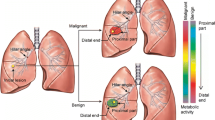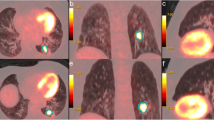Abstract
Objective
To assess the diagnostic value of fluorine-18 fluoro-2-deoxy-d-glucose positron emission tomography (FDG-PET) using standard uptake values (SUV) in the differential diagnoses of indeterminate pulmonary nodules. Specifically, we assessed the probability of malignancy for various SUV ranges, and compared the diagnostic efficacy of SUV with and without correction for partial volume effects on the basis of lesion size.
Methods
The FDG-PET scans performed on 158 patients with biopsy-proven pulmonary lesions seen on computed tomography (CT) scan were retrospectively reviewed. Histopathological confirmation was obtained to establish the diagnosis of the lesions. A region of interest (ROI) was drawn for each lesion, and FDG uptake was quantified (SUVraw). The SUVraw values were normalized for the “size” of the pulmonary lesions measured on CT (SUVsize). Sensitivity and specificity of FDG-PET for pulmonary lesions <2 cm in diameter or ≥2 cm in diameter were determined at SUV cutoff values of 2.5. The areas under the receiver-operating characteristic (ROC) curve for SUVraw and SUVsize regarding the presence of malignancy were compared for statistical differences. The frequency of malignant lesions for each range of SUVs was obtained to produce the probability of cancer (POC).
Results
The mean SUVraw was 3.17 ± 2.76 and 9.18 ± 6.72 for benign and malignant lesions, respectively. When a SUVraw value of 2.5 was used as a cutoff, sensitivity and specificity were 89% and 51%, respectively, for all lesion sizes. The sensitivity and specificity at a cutoff SUVraw of 2.5 for lesions less than 2 cm in diameter were 75% and 72%, respectively, and 92% and 41% for lesions 2 cm or greater, respectively. The sensitivity and specificity at a cutoff SUVsize of 2.5 were 88% and 42%, respectively. The area under the ROC curves for SUVraw and SUVsize was 0.816 and 0.743, respectively (P value 0.034). When the SUVraw was divided into three groups, the probability of malignancy was 26% when the SUVraw was <2, 57% for 2 ≤ SUVraw < 6, and 89% for SUVraw ≥ 6.
Conclusions
The FDG-PET is a reasonably accurate and useful tool for characterizing the nature of indeterminate pulmonary lesions, although the specificity was not as high as that reported in the literature, probably owing in part to our patient population and selection bias. Our data suggest that reporting the results of PET studies as a probability rather than as positive or negative for malignancy would be more useful for further management decision making. Correction of SUVs for tumor size did not improve accuracy.
Similar content being viewed by others
References
Hickeson M, Yun M, Matthies A, Zhuang H, Adam LE, Lacorte L, et al. Positron emission tomography imaging in nonmalignant thoracic disorders. Semin Nucl Med 2002;32:293–321.
Kubota K, Matsuzawa T, Fujiwara T, Ito M, Hatazawa J, Ishiwata K, et al. Differential diagnosis of lung tumor with positron emission tomography: a prospective study. J Nucl Med 1990;31:1927–1932.
Bury T, Dowlati A, Paulus P, Corhay JL, Benoit T, Kayembe JM, et al. Evaluation of the solitary pulmonary nodule by positron emission tomography imaging. Eur Respir J 1996;9:410–414.
Buck AK, Glatting G, Reske SN. Quantification of 18F-18-FDG uptake in non-small cell lung cancer: a feasible prognostic marker? J Nucl Med 2004;45:1274–1276.
Goo JM, Im JG, Do KH, Yeo JS, Seo JB, Kim HY, et al. Pulmonary tuberculoma evaluated by means of FDG PET: findings in 10 cases. Radiology 2000;216:117–121.
Keyes JW Jr. SUV: standard uptake or silly useless value? J Nucl Med 1995;36:1836–1839.
Bar-Shalom R, Valdivia AY, Blaufox MD. PET imaging in oncology. Semin Nucl Med 2000;30:150–185.
Midthun DE, Swensen SJ, Jett JR. Approach to the solitary pulmonary nodule. Mayo Clin Proc 1993;68:378–385.
Menda Y, Bushnell DL, Madsen MT, McLaughlin K, Kahn D, Kernstine KH. Evaluation of various corrections to the standardized uptake value for diagnosis of pulmonary malignancy. Nucl Med Commun 2001;22:1077–1081.
Gould MK, Maclean CC, Kuschner WG, Rydzak CE, Owens DK. Accuracy of positron emission tomography for diagnosis of pulmonary nodules and mass lesions: a meta-analysis. JAMA 2001;285:914–924.
Hubner KF, Buonocore E, Gould HR, Thie J, Smith GT, Stephens S, et al. Differentiating benign from malignant lung lesions using “quantitative’ parameters of FDG PET images. Clin Nucl Med 1996;21:941–949.
Dewan NA, Shehan CJ, Reeb SD, Gobar LS, Scott WJ, Ryschon K. Likelihood of malignancy in a solitary pulmonary nodule: comparison of Bayesian analysis and results of FDG-PET scan. Chest 1997;112:416–422.
Mazziotta JC, Phelps ME, Plummer D, Kuhl DE. Quantitation in positron emission computed tomography: 5. Physical-anatomical effects. J Comput Assist Tomogr 1981;5:734–743.
Nomori H, Watanabe K, Ohtsuka T, Naruke T, Suemasu K, Uno K. Evaluation of F-18 fluorodeoxyglucose (FDG) PET scanning for pulmonary nodules less than 3 cm in diameter, with special reference to the CT images. Lung Cancer 2004;45:19–27.
Detterbeck FC, Falen S, Rivera MP, Halle JS, Socinski MA. Seeking a home for a PET, part 1: Defining the appropriate place for positron emission tomography imaging in the diagnosis of pulmonary nodules or masses. Chest 2004;125:2294–2299.
Lillington GA. Management of the solitary pulmonary nodule. Hosp Pract (Off Ed) 1993;28:41–48.
Gupta NC, Maloof J, Gunel E. Probability of malignancy in solitary pulmonary nodules using fluorine-18-FDG and PET. J Nucl Med 1996;37:943–948.
Park K, Ashlock R, Chang W, Lahner J, Line BR, Kim CK. High variation in standardized uptake values among PET systems from different manufacturers (abstract). J Nucl Med 2007;48 Suppl 2:185 p.
Ramos CD, Erdi YE, Gonen M, Riedel E, Yeung HW, Macapinlac H, et al. FDG PET standardized uptake values in normal anatomical structures using iterative reconstruction segmented attenuation correction and filtered back-projection. Eur J Nucl Med 2001;28:155–164.
Author information
Authors and Affiliations
Corresponding author
Additional information
An erratum to this article can be found online at http://dx.doi.org/10.1007/s12149-010-0351-4.
Rights and permissions
About this article
Cite this article
Kim, S.C., Machac, J., Krynyckyi, B.R. et al. Fluoro-deoxy-glucose positron emission tomography for evaluation of indeterminate lung nodules: assigning a probability of malignancy may be preferable to binary readings. Ann Nucl Med 22, 165–170 (2008). https://doi.org/10.1007/s12149-007-0112-1
Received:
Accepted:
Published:
Issue Date:
DOI: https://doi.org/10.1007/s12149-007-0112-1




